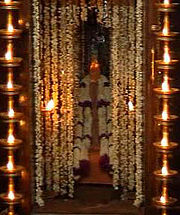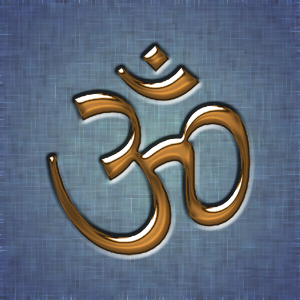
Lord Ayya Vaikundar, known to his followers as tenth avatar or incarnation of Lord Vishnu, also called as Sriman Narayana Vaikundasamy or Narayana Pandaram, was a 19th-century social reformer and iconoclast who worked for the upliftment of downtrodden people in the Kingdom of Travancore. He is central to the Hindu denomination of Ayyavazhi, as per holy scripture.

Ayyavazhi is a henotheistic belief that originated in South India. It is cited as an independent monistic religion by several newspapers, government reports, journals, and academic researchers. In Indian censuses, however, the majority of its followers declare themselves as Hindus. Thus, Ayyavazhi is also considered a Hindu denomination. Officially (legally), it exists within Hinduism as a Hindu denomination.

Akilathirattu Ammanai, also called Thiru Edu, is the main religious text of the Tamil belief system Ayyavazhi. The title is often abbreviated to Akilam or Akilathirattu.

Kroni is a figure in Ayyavazhi mythology. He is the primordial manifestation of evil, and manifests in various forms of evil, such as Ravana and Duryodhana, in different ages or yugas. In order to counteract and destroy the evil of Kroni's manifestations, Mayon incarnates as Avatars such as Rama and Krishna. He seems to be more evil than the demon Kali of the Mahabharata and Kalki Purana sharing similarities with Lucifer.
Netu Yukam, according to Ayyavazhi mythology, was a time when another fragment of Kroni was created into two wicked persons called Thillaimallalan and Mallosivahanan. They ruled over the people most wickedly by extracting Uliyam and Iraikal (taxes) from them. When it became unbearable, the Thevarkal complained to Isvaran, who in turn commissioned Lord Narayana to carry out the destruction of the wicked rulers, which he later did.
The fourth aeon was called Kretha Yukam, according to Ayyavazhi mythology. The third fragment of Kroni was, again, made into two siblings called Suraparppan and Sinkamuka Suran, and they were given responsibility to rule the earth. The wicked rulers began to crush the Thevarkal, who again reported it to Mayon. The Mayon took the form of Arumukan, the Tamil god, and advised the rulers to desist from their wickedness. But, when they spurned the advice arrogantly, Arumukan eliminated them too. During the same Yukam, Suraparppan was created again as Iraniyan. Mayon, incarnated as the son of Iraniyan, and challenged his authority, and finally taking on the therianthropic form of man and lion by piercing his stomach. In the death-bed Mayon asked him to repent. But he replied, arrogantly, that you cannot kill me only by placing ten mountains as ten nails you killed me and otherwise you can't.
According to the Ayyavazhi sect of hinduism, Thretha Yukam was the fifth of the Eight Yukams. In this aeon Isvaran created the fourth piece of the primordial Kroni as a Ten-headed mighty warrior, as per the request of Mayon, naming him as Ravanan, with ten heads as ten mountains.

Dharma Yukam is the state of absolute bliss as per Ayyavazhi mythology. Dharma Yukam is described in the Akilam seventeen in Akilathirattu Ammanai. It is related to Dharmic moksha and to Abrahamic heaven.
According to Akilattirattu Ammanai, the scripture of the Ayyavazhi religion, Ayya Vaikundar, the Incarnation of Lord Narayana in Kali Yukam, has five Seedar (disciples). They were in the previous Dwapara Yukam as Pandavas who were transmigrated as disciples of Vaikundar in this Yuga.

In the literature of Hinduism, Vinchai are proclamations and instructions to the newly born child Vaikundar, by his father Lord Narayana, also known as Vishnu, one of the three godheads in Akilathirattu Ammanai, the source of Ayyavazhi mythology. Three such Vichais took place during the period of Vaikundar; the first in Thiruchendur, immediately after his incarnation; the venue second and third Vinchais are in Muttapathi (sea), one by one between his incarnational activities.
According to Akilathirattu Ammanai the holy text of Ayyavazhi the present universe has eight aeons and we are in the seventh aeon, Kali Yukam.

The Santror are the seven boys who were brought to life by using the seven seeds from seven upper worlds, by Thirumal, to the Seven Virgins through their instrumentality, according to Ayyavazhi mythology. It also represents their descendants. According to Akilathirattu Ammanai, it additionally represents one who lives with Dignity.
Kalimayai is the illusion caused by the evil spirit of Kali Yukam, according to Akilattirattu Ammanai the source of Ayyavazhi mythology.
The following outline is provided as an overview and topic guide to Ayyavazhi:

Ayyavazhi and Hinduism are two belief systems in India. Although Ayyavazhi continues to officially exist within Hinduism and is considered by some observers to be a Hindu denomination, members of the religion claim that it is independent. The most notable distinction between Hinduism and Ayyavazhi is their different approaches to the concepts of good, evil and dharma.

The Akilam one is the first among the seventeen parts of Akilattirattu Ammanai, the religious book of Ayyavazhi. This section includes the Kappu, the very first part; it tells of the Detchanam, and describes the political and sociological situation in the early world.
In Ayyavazhi mythology, Neetiya Yuga is the first of the Eight Yukams. It was in this Yukam, Kroni was fragmented into six.
In Ayyavazhi mythology, Bhima Citar was one of the five disciples of Ayya Vaikundar. His native place is Karumbattoor, a small village in the district of Kanyakumari. He was Bhima, the most courageous among the Pandavas in the previous Dwapara Yukam, and was transmigrated and given birth in this Kali Yukam as Bhima Citar. In human history he was known as Pantaram.
The rituals that may be followed in Vedic religions after the death of a human being, for his or her peace and ascent to heaven are:

The Ayyavazhi symbolism deals with the symbols which are used in or used to represent Ayyavazhi. Though Akilam the scripture of Ayyavazhi does not point out any symbol directly, there are a few symbols which are used for representing Ayyavazhi which came into practice gradually.



